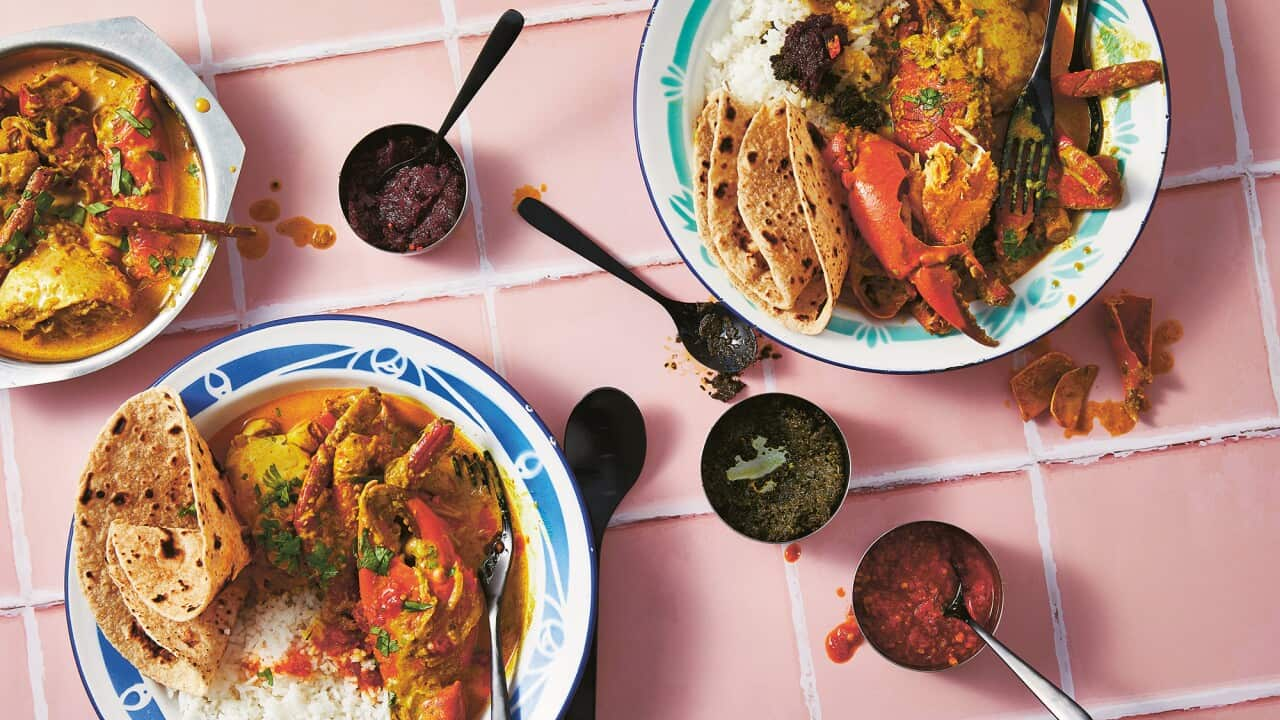As a kid, I remember watching Indian cooks. When they cooked a dish, they’d have a name for it. Even just for chicken curries – there’s jalfrezi-style chicken curry with fresh tomatoes, there’s a hariyali chicken curry with yoghurt at the base and so many other variants. But in my family, it was always just murgi tarkari, the Fiji Hindi words for chicken curry.
When I researched the history of Fijian-Indian culture, it was a mess. In the 1800s when the British colonised the world (thanks for that), they took a whole bunch of Indians all over the place. A lot ended up in Fiji, working in the sugar fields as indentured labourers. There were people from all over India in those fields. For generations, you had people from the north, central and south of India marrying each other on these small islands. Families were sharing language and recipes in this new environment and some things got lost in translation.

Justin Narayan and his book, 'Everything is Indian'. Credit: Murdoch Books
‘In my heart, I am Indian but my food is Fijian-Indian. It’s a mix of foods. We have embraced Fijian culture and they have embraced ours. Fijian-Indian food is very mild and simple.’ - Justin’s Mum
This was the food I grew up with, Parti and Mum’s rogue and resourceful Fijian version of Indian food. Of course, they never wrote any of it down (that’s a Western tradition, the Indian way of learning is to go into a kitchen and watch someone cook). The curries in my book are my attempt (and I think it’s a pretty good attempt) to translate their home cooking. But, like my grandma, use whatever is in your pantry or growing in your garden, change whatever you like and feel free to make it up. You’ve got my permission. The main rule is there are no rules.
WHAT FAT OR OIL TO USE
In Fiji, Mum used a seed or coconut oil, but when she came to Australia she started using olive oil. I’ve done tests with ghee, light olive oil and neutral oils. There isn’t a massive difference between olive oil and neutral oils, but with ghee you do notice it’s fattier and richer, which I don’t always like. The nostalgic oil for me is olive oil, so I use that.
HOW MUCH HEAT TO USE
I’ve put medium heat on most of the curry recipes, but traditionally most start with high heat to brown the onion, then lower to add the garlic and powdered spices. But to do that you need to have your prep done and organised, so you can move quickly. If you’re confident, smash the heat from the beginning.
TEMPERING
Tempering is simply cooking spices, onion and other aromats in oil. It’s the most pivotal part of getting flavour into a curry. Cooking spices in fat opens them up and releases their flavour and aroma. Technically, what you’re doing is infusing the oil; making a flavoured oil that will perfume and infuse the whole dish with flavour. Make sure you use a good amount of oil. You will know when the spices are ready, because the aroma will hit you. It’s the same for powdered and whole spices, but powdered spices don’t take as long – you’ll see most recipes add them later on. Be careful with powdered spices, because if they burn, they can be bitter and acrid.
ONIONS AND GARLIC
After tempering, the most important part of making a good curry is browning the onion – it adds depth, sweetness and savouriness. You’re looking for translucent onion with a thin bit of golden brown – go a little lighter on for veg curries and full golden brown for meat curries. A bit of char doesn’t hurt; as long as it’s not black and burnt, you’re fine. Garlic is different. Make sure you don’t burn it – a light golden brown is okay, but you don’t want to go further or it can give you a bitter, acrid taste.
SPICES
You can buy spices in bulk at Indian grocers way cheaper than at the supermarket. If you want a next-level flavour, get whole spices, toast them at home, then grind them. Also, remember spices (like all ingredients) vary. Your turmeric and the turmeric I use might be different in flavour. Same with chilli and any other ingredient. Always taste and make adjustments that work for you.

Chicken curry tacos with coriander green chilli chutney. Credit: Murdoch Books / Rob Palmer
GINGER AND GARLIC PASTES
Because I’m making so many recipes that require garlic and ginger, I keep jars of garlic and ginger paste in my fridge. I make my own in bulk. Get a whole heap of garlic and ginger, peel, roughly chop and blend each separately with a pinch of salt and a little oil (to help extend the shelf life), then place each in a clean jar and store in the fridge. For 1 cup (about 150 g) chopped garlic or ginger, go with a pinch of salt (2–4 g/1/8 oz) and 1–2 tablespoons oil. If you can’t be bothered, buy some, but I find the flavour of store-bought to be more subdued, so you may need to add more to the recipe to get the same impact as fresh garlic/ginger or a homemade paste.
This is an edited extract from by Justin Narayan, photography by Rob Palmer. (Murdoch Books, RRP $39.99)
MORE FROM JUSTIN NARAYAN

OG caramel slice and a barfi-spiced twist



